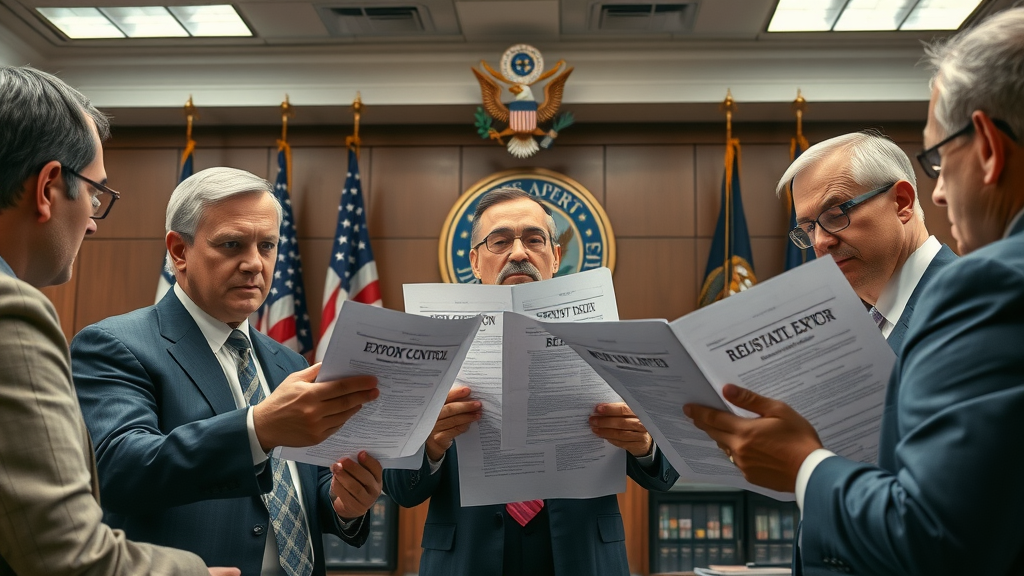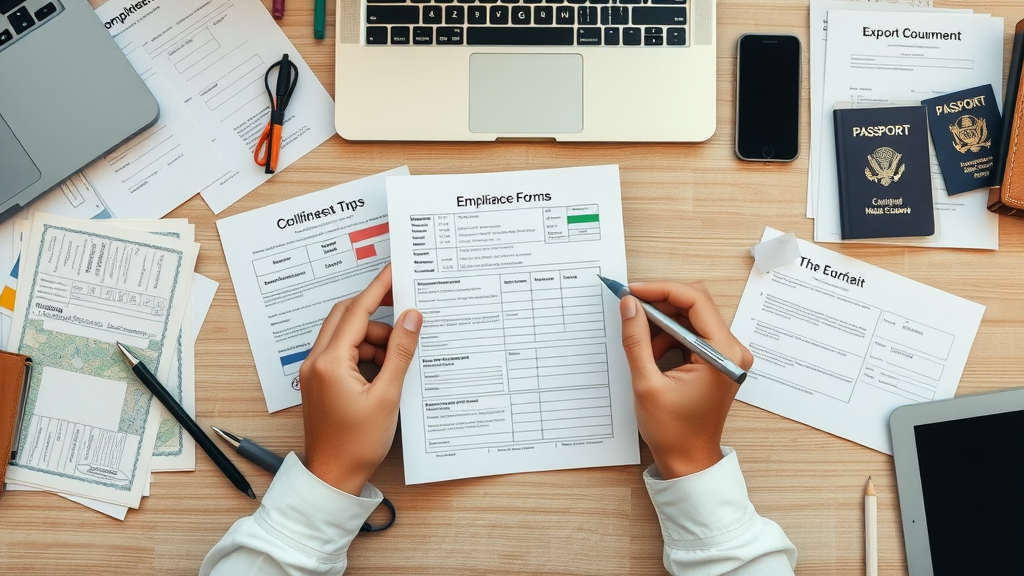Did you know that more than $2 trillion in goods cross global borders each year, yet 20% face setbacks due to export licensing delays? If you're feeling overwhelmed by the maze of export control laws, paperwork, and compliance checks, you're not alone. The good news: understanding export licensing unlocks faster export transaction times, shields your business from costly errors, and sets the stage for secure, global growth.
This definitive guide demystifies export licenses and the license application process. Whether you’re an experienced exporter, a startup stepping into international markets, or managing compliance for a large organization in the United States, we’ll cover the essentials—from export control basics and real-world scenarios to preparing your next license application with confidence. Let’s transform confusion into mastery—read on to discover what every global business must know about export licensing.

Unlocking the Facts: Why Export Licensing Matters More Than Ever
- Startling Fact: Over $2 trillion in goods cross borders each year—yet 20% encounter export licensing delays. Discover how understanding export licenses and export control can protect your business and accelerate compliance.
The global movement of goods is at an all-time high, making export licensing a mission-critical process for businesses involved in international trade. With so much at stake, even a minor misunderstanding of export control rules can trigger major export licensing setbacks. Many companies learn this the hard way when their shipments get held up at customs, or worse, when non-compliance results in hefty fines or damaged reputation.
By developing a deep understanding of export license types, control lists, and the application process, businesses protect themselves and enhance their global competitiveness. Compliant operations not only reduce the risk of disruption but also build trust with partners, governments, and customers worldwide. In a rapidly changing regulatory landscape—especially in the United States where export control classification number standards evolve regularly—it’s no longer optional to grasp these fundamentals. Instead, navigating export licensing with confidence has become a vital skill for every exporter.
Understanding Export Licensing: What Every Exporter Needs to Know
Defining Export License: Essential Concepts for Global Trade
An export license is an official document issued by a government organization—often the Department of State or Commerce in the United States—that authorizes the export of specific goods or technologies to a particular destination. Obtaining an export license ensures your items aren’t subject to restrictions, embargoes, or special export control laws. Not all shipments require export licenses, but it's crucial for exporters to determine if their commodity falls under controlled items or appears on an export control classification number (ECCN) list. Ignoring this step may result in unsafe or illegal exports, leading to severe penalties and trade disruptions.
Export licenses come in various forms depending on product type, end-use, end-user, and destination country. For instance, high-tech goods, military-related items, or products shipped to embargoed countries nearly always require a license application. Understanding what constitutes a controlled item and how to classify your goods prepares you for compliance and smooth cross-border shipments.
The Role of Export Control: Frameworks and Legal Requirements
Export control frameworks are legal structures established by governments to regulate the dissemination of goods, software, and technology—primarily to safeguard national security, support foreign policy objectives, and honor international agreements. In the United States, agencies such as the Department of Commerce’s Bureau of Industry and Security (BIS) and the Department of State oversee these regulations. Export control requirements apply not just to military equipment, but increasingly to dual-use civilian goods and advanced technologies that could have military implications.
Knowing which agency has jurisdiction over your export transaction and being aware of the export control classification number for your product is key. Each agency provides official guidance through their official website , where you can access export control lists and export license application guidelines. This due diligence protects your company from regulatory missteps, helps identify controlled items, and demonstrates to partners that you are safely connected and compliant with global trade laws.
Export Licenses in Practice: Real-Life Scenarios
Consider a U.S.-based tech firm shipping encryption software overseas. They must consult the export control classification number and submit a license application, ensuring their product isn’t destined for a sanctioned country or a restricted end-user. In another case, an industrial exporter may find that their sensors for oil exploration need an export license due to potential dual-use in military applications. In both cases, a misunderstanding or omission in the license application process can cause delays, seizures, or legal consequences. Therefore, experienced exporters consult official government organization portals and maintain thorough compliance documentation for every export transaction.

Types of Export Licenses and Their Applications
Individual Export License vs. General Export License: Choosing the Right One
Navigating license types is crucial—choose incorrectly and your business could face unnecessary complexity or compliance gaps. An Individual Export License is a specific grant of authority allowing a particular exporter to ship certain items to specified end-users and destinations, typically for sensitive items, technologies, or countries under strict export control . This license mandates a rigorous application process, demands detailed information, and often carries shorter validity periods.
In contrast, a General Export License (sometimes called a general license or license exception) allows exporters to ship widely traded, low-risk goods that don’t require an individualized government review—provided all specified conditions in official government regulations are met. Understanding which category your shipment falls under—or if you may proceed using a license exception —is a foundational step before entering any export transaction.
| License Type | Application Process | Validity | Suitable Commodities | Common Pitfalls |
|---|---|---|---|---|
| Individual Export License | Detailed license application submitted via gov website or official website ; requires end-use and end-user info; review by relevant agency | Typically 1-2 years, sometimes shipment specific | Controlled items: high-tech, dual-use, military, items for restricted countries | Incomplete documentation, misclassified ECCN, missed embargoed destination, underestimating time needed for approval |
| General Export License / Exception | No formal application; eligibility self-determined by exporter using regulations on official government website | As long as requirements are met and regulations unchanged | Non-sensitive, widely traded goods, not on control lists | Misinterpreting eligible items, overlooking recent export control updates |
When Is a License Application Required? Step-by-Step Guidance
Not sure when a license is required? Start by determining your product’s export control classification number (ECCN) using the relevant government website or secure website resources. Next, analyze the destination country: many jurisdictions are embargoed or restricted by agencies such as the U.S. Department of State. You’ll also need to evaluate the end-use and end-user—certain uses or customers (e.g., military or prohibited organizations) can trigger an export licensing requirement even for otherwise uncontrolled commodities.
If your product, user, or destination appears on a control list or if the shipment involves sensitive information, an export license is typically mandatory. Begin your license application on the appropriate gov website —these secure websites guide exporters through form completion and document uploads. Failing to apply when required may result in denied shipments, financial penalties, or official investigations. Consult official government documentation or work with a compliance expert if in doubt.
Export Control Regulations: Staying Compliant and Avoiding Penalties
Key Export Control Agencies and Their Jurisdictions
Multiple government agencies—which may have overlapping authority—oversee export control. In the United States, the Department of Commerce’s BIS manages dual-use items under the Export Administration Regulations (EAR), while the Department of State controls defense and military-related exports via the International Traffic in Arms Regulations (ITAR). Additional oversight often comes from the Department of Treasury’s Office of Foreign Assets Control (OFAC), which enforces embargoes and sanctions lists. Each agency’s official website offers searchable control classification number (ECCN) databases, export control lists, and application instructions.
Staying organized means verifying which agency has jurisdiction over your commodity and ensuring all export licensing submissions are coordinated accordingly. Each agency’s export control procedures and requirements are distinct, so never assume a license exemption applies without officially checking regulations at their gov websites . Remaining compliant protects your business from enforcement actions and upholds your firm’s global reputation.

Common Export Control Errors and How to Avoid Them
Even experienced exporters stumble into pitfalls, such as submitting incomplete license applications , using outdated product classifications, or ignoring recent embargo updates. Other frequent mistakes include assuming general licenses are valid without confirming eligibility, or neglecting re-export controls when goods transit multiple countries. Many of these errors stem from overlooking agency updates on official government organization websites or failing to monitor export control classification number changes.
To sidestep these traps, always conduct a fresh regulatory check before any major export transaction and maintain robust internal training on current export license rules. Partnering with compliance consultants and leveraging automated compliance tools from secure websites can also reduce the risk of inadvertent violations.
"Understanding export control isn’t just about compliance—it’s about safeguarding your business from costly disruptions and reputational harm."
Step-by-Step Export License Application Process
Preparing Your Export License Application: Documents and Data Needed
A strong export licensing application streamlines review and approval. Compile detailed product descriptions, relevant export control classification numbers , end-use statements, end-user information, and shipping routes. Government agencies may also request technical specifications, contracts, prior correspondence, and sometimes even the product’s full technical drawings. Verify the accuracy of every entry and double-check that all supporting documents align with the requirements listed on the gov website .
It’s vital to keep sensitive information organized and secure— official websites and secure portals use encryption to ensure your data is safely connected during submission. Commonwealth errors like missing attachments or mismatched details between forms and documentation can trigger delays or denials, so meticulous attention to detail is a must.

Export License Approval Timeline: What to Expect
Export license processing times vary by commodity, agency, and regulatory environment. Routine product shipments might be approved within days, but complex or sensitive goods—especially those regulated by the Department of State—can take several weeks or longer. High-security or high-value requests often undergo multi-agency review, extending the approval timeline further. Stay proactive by submitting your application well before scheduled shipment dates and monitoring the process via secure gov website dashboards.
- Required Documentation for Export Licenses: Country of destination, commodity details, export control classification numbers
Throughout the process, respond promptly to any agency follow-up requests for clarification or supplemental documents. Regularly check status updates on secure government portals to ensure you remain safely connected and prepared for any regulatory changes that could affect processing times.
People Also Ask: Answers to Common Export Licensing Questions
What is exporting and licensing?
Exporting means sending goods, services, or technology from one country to another. Export licensing involves obtaining formal government permission—called an export license—to ship certain regulated products abroad, especially those listed on export control classification number charts or subject to export control restrictions.
What items require an export license?
Items needing an export license often include advanced technology, software with encryption features, military equipment, medical devices, controlled chemicals, and goods destined for embargoed or sanctioned countries. The full list is governed by export control regulations published on official government websites .
How much does it cost for an export license?
Government fees for export licenses vary widely by jurisdiction, agency, and commodity. Some U.S. agencies process routine applications at no charge, while sensitive or complex applications can cost several hundred dollars. You may also face costs for compliance consulting and documentation support if you engage external help.
How do I know if my shipment requires an export license?
To determine whether a license is required for your shipment, classify your product by ECCN, check its destination against current export control regulations, and assess the intended end-use and end-user. When in doubt, consult the control lists on agency official websites or seek advice from an experienced compliance professional.
Essential Export Licensing Checklist for Global Businesses
- Identify restricted products
- Research export control lists
- Determine export license requirements
- Gather complete supporting documentation
- Submit a thorough license application
- Monitor for regulatory updates on official government organization pages

Case Studies: How Companies Benefit from Strong Export License Compliance
Success Story: Streamlining Processes to Avoid Export Control Delays
One electronics manufacturer, initially plagued by repeated shipment delays, overhauled its export licensing procedures by training its team in ECCN classification and automating license applications through secure websites. As a result, license approvals accelerated by 35%, and denied or delayed shipments dropped significantly. This proactive approach saved the company hundreds of thousands of dollars annually and improved relations with global customers by ensuring shipments arrived on time.
The keys to success included standardized internal workflows, regular review of export control agency updates, and centralized documentation on secure government portals. By understanding when a license is required and staying ahead of regulatory changes, they ensured sustainable, scalable global growth.
Lessons Learned: Mistakes That Can Jeopardize Export Licenses
In contrast, a software exporter overlooked a simple change to the export control classification number and shipped product to a restricted destination. The result: temporary suspension of their export privileges and costly legal reviews. This underscores the need for regular compliance training, internal audits, and immediate response to regulatory updates. Small mistakes—like incorrect documentation or outdated license applications—can put your export licenses and hard-earned reputation at risk.

Expert Tips and Resources: Mastering Export Licensing Rules
- Regularly review updated export control regulations
- Leverage official government portals for export licenses
- Establish an internal compliance program
To master export licensing, make it a habit to monitor the official website of relevant export control agencies for rule changes and control list updates. Use secure websites for all license application processes to safeguard sensitive information, and create detailed checklists—tailored to your product line—to ensure every license application is complete and accurate. Training your staff and assigning specific compliance roles go a long way toward building lasting regulatory expertise within your organization.
FAQs on Export Licensing: Quick Reference
- Who needs an export license? Any exporter shipping controlled items, sensitive technology, or goods to embargoed destinations—verify requirements per official websites.
- How long is an export license valid? Most licenses are valid for 1-2 years or until all approved shipments occur, but check specific agency rules for exact terms.
- Can an export license be amended after approval? Yes, most agencies allow license amendments for changes in destination, item, or end-user—contact the agency or check the gov website for amendment procedures.
- What are the penalties for non-compliance with export control? Penalties range from revoked licenses and shipment seizures to significant fines and criminal prosecution, depending on severity and intent.
Your Next Steps: Become an Export Licensing Pro
Stay Ahead: Best Practices for Ongoing Export Control Compliance
Implement a robust internal compliance program; schedule periodic staff training on regulatory updates; use secure websites for all documentation; and maintain direct lines to agency contacts for quick resolution of questions or issues.
Connect with Export Licensing Experts
Partnering with experienced consultants, engaging with trade associations, and leveraging government-provided compliance resources ensures that your company remains agile and compliant in the face of shifting export license requirements.
"Staying proactive with export licensing ensures not only legal compliance but also positions your business for seamless growth in global markets."
Ready to Share Your Experience? Join the Global Trade Conversation
- Have insights to share on global trade? Let's talk—call us at 203-271-7991 to explore contributing an article.
Take action today: Strengthen your export licensing procedures, consult with compliance experts, and become a force for secure, efficient global trade.
Navigating the complexities of export licensing is crucial for businesses engaged in international trade. To assist you in this endeavor, the Bureau of Industry and Security (BIS) offers comprehensive guidance on determining whether a license is required for your export transactions. Their official page, “Licensing | Bureau of Industry and Security,” provides essential resources, including training videos, decision tools, and access to the Export Administration Regulations (EAR). ( bis.gov )
Additionally, the International Trade Administration (ITA) offers valuable insights into U.S. export regulations. Their resource, “U.S. Export Regulations,” outlines the roles of various agencies involved in export licensing and provides training on the EAR. ( trade.gov )
By leveraging these authoritative resources, you can gain a clearer understanding of export licensing requirements and ensure compliance with U.S. regulations, thereby facilitating smoother international transactions.
 Add Row
Add Row  Add
Add 




Write A Comment